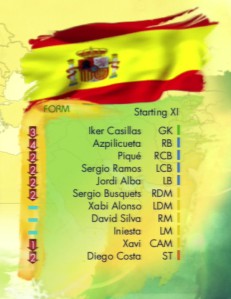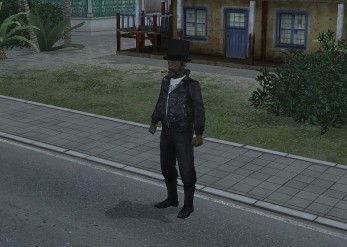The “official games” of major sporting events such as the Olympics and the FIFA World Cup have traditionally been terrible. Short on polish or features, the games have felt like they were made on the basis that people were buying them more as a souvenir and without any regard for whether they provided any actual entertainment.

“Official” games have often had wonderfully rendered stadiums but offered very little interest inside of them.
I had heard however that the 2010 FIFA World Cup game was actually quite good. So I decided to make the investment this time and see how the game is. The short answer is that it is a good game, but you can get that from any other review. What I am going to look at here, is whether the game actually makes the whole ‘experience’ of the World Cup better.
In my opinion, there are two main things that a game like this needs to do. Prior to the tournament it needs to enable you to get ready and hyped up about the games ahead, and during the tournament it needs to allow you to play the games you are about to/just watched as realistically as possible.
This game achieves both of those very well.
Prior to the tournament
The obvious thing which the game needed to do out of the box was make it possible to play through the World Cup tournament. Unsurprisingly, it does this quite well. All the basic things are there, the stadiums, fixtures, the 32 qualified teams and their correct uniforms.
Beyond that, it also needs to make it possible to play through the tournament with a few “what if” situations, for example, you should be able to play through with teams that didn’t actually qualify, or using players for whom your personal attachment doesn’t match the opinions of the actual real-life manager (e.g. Carlos Tevez). The first part of this it does quite well, pretty much every single nation in world football is represented. Unfortunately it isn’t so good on the latter. The squads for nations, while larger than the final 23-man selections, don’t go far and have some strange omissions, so you can’t call up Tevez for Argentina.
In addition to enabling you to play the finals tournament itself, the FIFA World Cup game put a lot of attention into telling the story of the qualifiers. This is a common inclusion, but always a bit interesting, since qualification was well over by the time the game came out.
The game presented qualification in not one, but two ways. Firstly, it allows you to play a complete qualification campaign with any team from any confederation. The best part of this was the presentation, which came complete with excellent radio commentary between the games, talking through the significance of each match and providing general interesting banter. The low point of the qualifying campaign is that there are apparently some nations, particularly in North America, where the scheduling is broken, so they can’t actually qualify for the World Cup. A fairly fatal flaw, made reasonable only by the fact that those nations are for the most part the smallest of minnows.
The other qualification-related mode is the “Story of Qualification”, a series of scenario-based games which cover over 50 of the most interesting and significant games of the qualification campaign. For example, it allows you to play both sides of the decisive playoff game between Sweden and Portugal. For anyone who has played FIFA games in the last few years, these scenarios should be familiar from the game of the week scenarios that you get – typically they boil down to needing to score a crazy number of goals in a very short amount of time.

The Story of Qualification mode allows you to play through some of the great games and performances of the qualifying campaign.
The game genuinely has absolutely helped me build hype and excitement for the tournament. I have played through three world cup tournaments, full European and South American Qualifying, plus a large number of scenarios. Between these, I have been able to get a much deeper understanding of the squads and how they have made it to Brazil. In particular the Story of Qualifying scenario mode was excellent. I don’t think many people, even fairly serious fans, ever truly get an idea of what qualification is like in confederations beyond their own. But now I feel I have a fairly good idea.
During the Tournament
As I hinted earlier, in my opinion the key function of the game during the tournament is to allow you to “play along”. Again, this is something that the game does quite well.
Firstly, it was quite easy to set up a tournament in such a way that I can play the World Cup as every team. This allows my mates and I to play an “alternate reality” version of the tournament where we play every game between us and see how it goes. As it turns out, our version is a little less interesting, the first three games were draws and then Spain beat the Netherlands 1-0.
It is also very easy to play one-off games. You can pick your teams, pick the right stadium and even select the right round of the completion (group stage, quarter final etc). The teams are quickly and regularly updated for injuries and current form, so if you want to play out tonight’s big game, or get revenge for last night, you can do that well. You just might struggle sometimes, because Casillas will probably be as bad for you as he was for Spain.
Finally, they have also extended the scenario system through to the Finals, called, unsurprisingly, “Story of the Finals”. Within hours of each day’s games finishing, they put up scenarios which allow you to play out the morning’s action. Sometimes this is about repeating reality, such as coming back against Japan as the Ivory Coast, and other times it is about changing it, such as winning the game as Australia, or making Argentine put four goals past Bosnia. In general this is excellent. I applaud them for making them available so quickly, and unlike in previous games, making them available permanently – previously they would just have the previous night, so you could miss out if you didn’t play them immediately.
I do find however that the whole “score lots of goals in a short time” which most scenarios tends to boil down to is not only samey, but also quite annoying, and only representative of the attacking aspect of a game. I often find I have to play the scenarios at a much easier difficulty level than I normally do, simply to make it possible to achieve without replaying the scenario 100 times.
I wish that they would make the scenarios either much longer, or much shorter. Allowing you to play the entire opening game with the objective “Win as Brazil” with bonus points for doing so without conceding a goal would allow you to actually appreciate the ebb and flow of the game. Alternatively cutting the scope right down to “Replicate Neymar’s stutter-step penalty” would show-off little features like that in the game which you otherwise might not notice or use. In both cases, it would also make it easier to simply enjoy playing the scenarios at my normal level, rather than have to get bored hammering in goals against the dumbest version of the AI simply to get through them.
Conclusion
Despite a few minor foibles, the game genuinely does make the whole World Cup experience more enjoyable!







